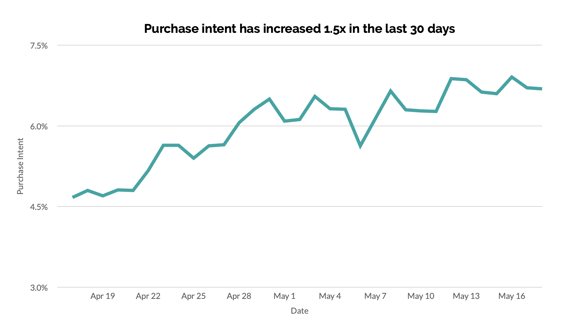
It’s almost June, and that means some of the most highly anticipated annual shopping occasions from retailers such as Amazon, Target, and Walmart are coming up. While key players such as Amazon and Target have yet to announce official dates, we do know that Prime Day is hinted to be in June, and that Target and Walmart will be launching its sales days around the same time. Brands should be preparing and making sure that their media and strategy will maximize traffic and sales at retailer sites this year.
Here’s what they’ll need to know.
What are retailer driven shopping occasions?
Sales and discounts have always been part of a retailer’s strategy, and consumers love a good deal. When they know to anticipate discounts, consumers plan their shopping activity around it. While initially announced as a day to commemorate its 20th anniversary, Amazon’s Prime Day is now a two-day annual event where shoppers anticipate deep discounts throughout the site. Since its launch, other retailers such as Target, Walmart, Best Buy, and more have joined in, lowering their prices around the same time to compete with Amazon and to take advantage of this time of shopper frenzy.
When retail giants like Amazon, Walmart, and Target announce the dates to look out for savings, consumers respond and brands follow. Thus, retailer driven shopping occasions are created. Last year, Prime Day was delayed to October 13 and 14, and retailers like Target and Walmart followed suit. Together, they moved the holiday season for online shopping a full month earlier. Back to School had barely ended when retailers kicked off the shopping season, starting from these deal days and into Black Friday, Cyber Monday, and beyond. In the end, some like Amazon saw Prime Day 2020 bring in about $10.4 billion in sales. Others like Target saw Deal Days revenue grow 2.5 times over the prior year.

We anticipate another impressive performance this year. Cinco de Mayo kicked off the summer shopping season, and consumers are planning to buy for the hotter days ahead, especially as parts of the US reopens. Currently, even without knowing the exact dates for these deals this year, consumers are already gearing up to buy — in the last 30 days, purchase intent across categories and channels has increased 1.5x. With Memorial Day happening at the end of May, these retailer shopping occasions will take the baton and move this eCommerce season throughout June and into July.
Grocery, health care, and home care top industries to watch
Amazon announced that last year’s top selling items were in the technology, home care, grocery, health care, and toy categories. Target reported electronics, home care, and toys as high performing categories for Deal Days. Our shopping index from Prime Day 2020 reflects similarly: beauty, grocery, and home care were top performers. Health care, personal care, infant care, and technology were not far behind.
We anticipate these categories to perform this year as well.
Beauty continues to be a key industry to watch as we near a safe return to social gatherings. In addition to being a high performer last year, the beauty industry is currently reporting to be growing at 4.75 percent, up from $483 billion in 2020 to $511B in 2021. Grocery comes as a close second as eGrocery sales grew 54% in 2020 to $95.8 billion, and are expected to surpass $100 billion this year. Last year, home care products like disinfectants or toilet paper saw an infamous surge in eCommerce and will continue throughout 2021 with new shopping habits in place — 1 in 2 shoppers claim to purchase non-food categories like personal care and cleaning products exclusively online. eCommerce for infant care is expected to see a growth rate of 20 percent worldwide and the toy industry as a whole is expected to continue growing at a rate of 4.4 percent.
How should brands be preparing to get ahead?
If you’re a brand participating in this year’s retailer driven deal days, here’s how to effectively leverage the coming surge in purchase intent in these growing categories:
- Gather actionable eCommerce insights ahead of the big day.
Consumers know that these deal days are coming, and they will be doing their product discovery, research, and purchase planning up to a month before the actual day. Now is the time to make sure that you are getting visibility into how your marketing channels off of retailer sites are driving sales on them. This information can be used to optimize your media mix across search, video, influencers and more, and help you plan for the big day. - Expect shoppers to be on many retailer sites.
Remember when we said that purchase intent over all has increased 1.5x across industries in the last 30 days? That’s across retailers too. Up to a month before the deal days, consumers will be paying more attention to and doing research in preparation for them. They’ll be comparing not just products, but also where they plan to get it. When deals are taking place across retailers, omnichannel factors such as fulfillment options and delivery time, in addition to price, will play into where the final purchase is made. - Make sure your products are discoverable across all channels.
Retailer sites like Amazon are great for product recall, but not so much for product discovery. That means, if consumers don’t already know about your product or brand before the big day, there’s a high chance they won’t make that purchase. According to the MikMak Shopping Index, last year Facebook and Instagram were the most successful drivers of purchase intent for Amazon, followed by Google, Pinterest, and Youtube. Other platforms had industry affinity, such as Snapchat for healthcare brands. - Plan your inventory to match consumer demand.
Look at where your consumer purchase intent is high by channel and geography and plan ahead so you don’t run out of stock. - Optimize your product display and listings.
The better your listings are at explaining and showcasing the benefits of your products, the more likely you’ll be to persuade consumers to finalize a transaction. - Create a killer brand experience.
Know and own your audience, eliminate your competition on product display pages, and make sure your authorized sellers surface first.
Wondering which channels are the most “shoppable” for your brand? Take a look at our metrics guide to learn how to optimize your strategy for upcoming deal days and other big shopping events this year.


